Come trascorrere un giorno a Roma
Ah, Rome! A city that’s like a giant history book you can walk through, with stories lurking in every nook and cranny. The journalist Silvio Negro wasn’t exaggerating when he coined the phrase “Roma, non basta una vita” (Rome, a lifetime is not enough).
While this sentiment provides a good excuse to return time and again, let’s face it, we can’t always indulge in such luxury, can we? So when you’ve got just a day to spare, you want to make it an adventure to remember. And believe me, even a brief encounter with Rome will forever etch itself into your memory!
Now, forget those crazy itineraries that leave you wondering if you’ll ever have time to enjoy that plate of carbonara you’ve been dreaming about. We’re not in a race against the clock here. Our goal is to relish each moment and strike the perfect balance between the big sights and the culinary delights that make Rome so special.
So, ditch the stopwatch and embrace the joy of leisurely exploration. Rome wasn’t built in a day, and you won’t see it all in one either. But hey, we’ll make sure every moment is filled with wonder!
Ah, Roma! Questa città è come un enorme libro di storia da scoprire passeggiando, con storie che si celano ad ogni angolo. Il giornalista Silvio Negro non esagerava quando ha coniato la frase “Roma, non basta una vita”.
Sebbene questa sensazione possa fornire un’ottima scusa per ritornare più e più volte, ammettiamolo, non sempre possiamo permetterci tale lusso, vero? Così, quando hai solo un giorno da dedicare alla città, giustamente desideri renderlo un’avventura indimenticabile. E credimi, anche un piccolo assaggio di Roma resterà impresso per sempre nella tua memoria!
Ora, dimentica quegli itinerari frenetici che ti fanno domandare se mai avrai il tempo di gustarti quel piatto di carbonara che sogni da tanto. Questa non è una corsa contro il tempo. Il nostro obiettivo è godere di ogni istante, trovando il perfetto equilibrio tra le grandi attrazioni e le delizie culinarie che rendono Roma così speciale.
Quindi, metti via il cronometro e divertiti ad esplorare senza fretta. Roma non è stata costruita in un giorno, e di certo non riuscirai a vederla tutta in 24 ore. Ma hey, faremo in modo che ogni momento sia ricco di meraviglia!
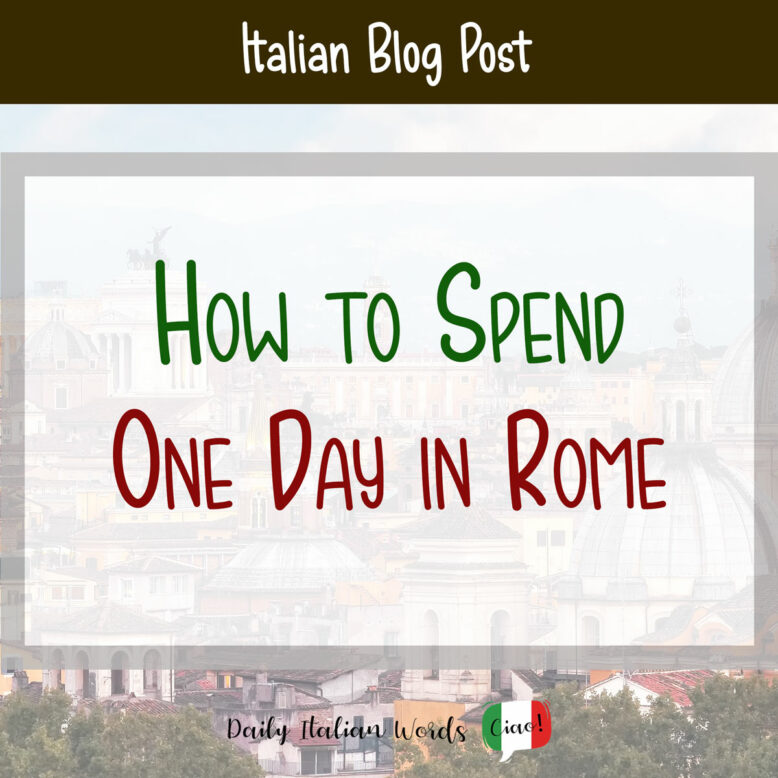
Itinerary for one day in Rome
While one day in Rome can be enjoyed in myriad ways depending on what you’re into (food, art, culture, you name it), consider this itinerary as a personal recommendation for first-time visitors, covering some of the major sights and neighborhoods. However, please note that we won’t be heading inside any spots, though (let’s stay realistic!), so no St. Peter’s or Vatican Museums this time – sorry!
Oh, and just a quick heads up – we’ll be walking most of the time, so make sure to put on your most comfortable shoes to fully enjoy the experience!
Itinerario per un giorno a Roma
Ci sono tantissimi modi per trascorrere un giorno a Roma in base ai propri interessi (cibo, arte, cultura o altro ancora), ma questo itinerario è pensato come una guida personale per coloro che visitano la città per la prima volta. Attraverso questo percorso, viaggeremo tra alcuni dei luoghi più iconici e dei quartieri più caratteristici di Roma. Tuttavia, fatta eccezione per rare occasioni, eviteremo di entrare nelle attrazioni principali (dobbiamo essere realisti), quindi niente San Pietro o Musei Vaticani questa volta – mi spiace!
Ah, un veloce avviso – cammineremo per la maggior parte del tempo, quindi assicurati di indossare le scarpe più comode che hai per goderti appieno l’esperienza!

Starting point: Termini Station
If you are in Rome for a day, chances are you’ll arrive by train at the Termini station, so let’s kick off our adventure right here. If you’re staying overnight, book a hotel nearby so so you can drop off your stuff and hit the ground running. And if you’re just passing through for a few hours with some luggage weighing you down, drop it off at one of those handy storage spots at the station (just remember to book online beforehand to save yourself some time).
A mere five minutes walk from Termini lies the Panificio Roscioni. I recommend stopping by and ordering a delicious maritozzo with whipped cream – it’s the perfect fuel to kickstart this Roman adventure!
Punto di partenza: la stazione Termini
Se sei a Roma per un giorno solo, è molto probabile che arrivi in treno alla stazione Termini, quindi sarà da qui che inizieremo la nostra avventura. Se resti in città per la notte, prenota un hotel nelle vicinanze in modo da poter lasciare i tuoi bagagli e iniziare subito a esplorare. Per chi invece ha solo poche ore a disposizione e porta con sé bagagli ingombranti, consiglio di utilizzare i comodi depositi disponibili presso la stazione (ricorda di prenotare online per risparmiare tempo).
A cinque minuti a piedi da Termini c’è il Panificio Roscioni. Ti consiglio di andarci e acquistare un bel maritozzo con panna – è il carburante perfetto per dare il via a questa avventura romana!
First stop: the Colosseum
Hop on metro line B at Termini (heading towards Laurentina), and after just two stops, you’ll be face-to-face with the legendary Colosseum, Rome’s ultimate superstar! This grand amphitheater was born from the mind of Emperor Vespasian, who wanted to gift the Romans with the ultimate entertainment extravaganza. And indeed, it lived up to its promise, being inaugurated in 80 A.D. with 100 days of non-stop celebration!
Capable of accommodating up to 50,000 spectators, the Colosseum boasted specific sections for each social class. Its spectacles ranged from gladiator battles to fights with exotic animals, with certain periods seeing the arena flooded to simulate naval battles!
But the Colosseum’s significance extends beyond its grandeur. Remarkably, this amphitheater served as the unsung hero behind some of Rome’s most iconic landmarks. Over the centuries, the marble blocks that once covered it were repurposed in the construction of other important structures, including the Holy Staircase, St. Peter’s colonnade, Palazzo Barberini, and Palazzo Farnese. Hence, the Colosseum stands as the perfect inaugural stop for a day in Rome.
Prima tappa: il Colosseo
Prendi la linea B della metropolitana a Termini (direzione Laurentina), e dopo appena due fermate, ti troverai faccia a faccia con il leggendario Colosseo, l’indiscussa rockstar di Roma! Questo grande anfiteatro fu concepito dall’Imperatore Vespasiano con l’intento di donare ai romani un’arena per spettacoli e intrattenimento. Sicuramente riuscì nel suo intento, tanto che fu inaugurato nell’80 d.C. con ben 100 giorni di festeggiamenti!
Il Colosseo poteva accogliere fino a 50.000 spettatori, con settori specifici per ogni classe sociale. Gli spettacoli includevano combattimenti tra gladiatori, scontri tra animali esotici e addirittura, in certi periodi, l’arena veniva allagata per simulare battaglie navali!
Ma il Colosseo non è celebre solo per la sua grandiosità. Che tu ci creda o no, dietro alcune delle più iconiche attrazioni di Roma si cela il Colosseo. Nel corso dei secoli, infatti, i blocchi di marmo che lo rivestivano sono stati usati per costruire altri importanti edifici, tra cui la Scala Santa, il loggiato di San Pietro, Palazzo Barberini e Palazzo Farnese. Ecco perché il Colosseo rappresenta la tappa perfetta per iniziare questa giornata a Roma.
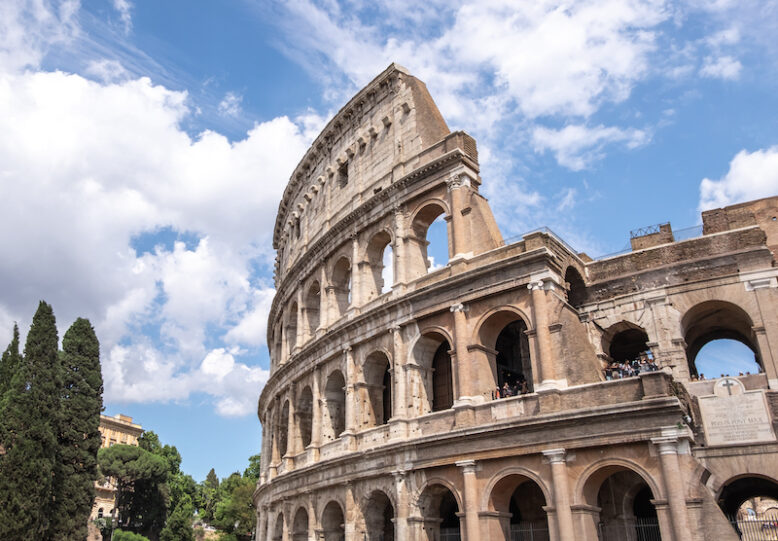
Piazza Venezia
Take a stroll down Via dei Fori Imperiali, a splendid boulevard flanked by the remnants of the mighty Imperial Forums, which once served as the commercial and political heart of ancient Rome. Within just 15 minutes, you’ll arrive at Piazza Venezia, named after its historical significance as the site of the embassy of the Republic of Venice during the 16th century.
The star of the show here is the magnificent Vittoriano, a dazzling marvel crafted from pristine white marble, dedicated to Vittorio Emanuele II, the first king of Italy, who’s depicted in a grand equestrian statue (rumor has it that 24 people once dined inside its colossal structure!).
The Vittoriano is also known as the Altar of the Fatherland, because in 1921, it became the final resting place of the Unknown Soldier, commemorating all those who died in World War I. Within its walls, the Vittoriano houses the Museum of the Risorgimento and the Shrine of the Flags. And for €17, you can ascend to the beautiful panoramic terrace, standing at a height of 80 meters, where the eternal city unveils its splendor in all its glory.
Piazza Venezia
Passeggia lungo Via dei Fori Imperiali, un’incantevole viale con vista sui maestosi resti dei Fori Imperiali, un tempo cuore pulsante del commercio e della politica nell’antica Roma. In soli 15 minuti, giungerai a Piazza Venezia, così chiamata poiché nel XVI secolo ospitava l’ambasciata della Repubblica di Venezia.
Il protagonista indiscusso di questa piazza è il magnifico Vittoriano, un’imponente struttura in candido marmo bianco dedicata a Vittorio Emanuele II, il primo re d’Italia, immortalato in una grande statua equestre (si narra che ben 24 persone siano riuscite a cenare al suo interno!).
Conosciuto anche come Altare della Patria, dal 1921 il Vittoriano è il luogo di sepoltura del milite ignoto, a ricordo di tutti coloro che persero la vita durante la Prima Guerra Mondiale. Al suo interno, il Vittoriano ospita il Museo del Risorgimento e il Sacrario delle Bandiere. E per soli €17, potrai salire fino alla splendida terrazza panoramica, che, ad un’altezza di ben 80 metri, regala una vista mozzafiato sulla città eterna.
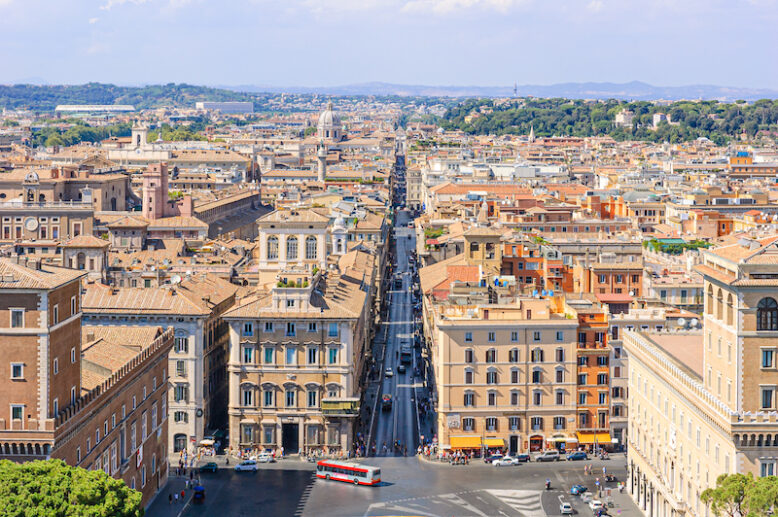
Church of San Ignazio da Loyola
Step into the lively hustle and bustle of Via del Corso, one of Rome’s main streets. As you amble along, keep an eye out for Via del Carovita on your left. Following it will lead you to the Church of San Ignazio da Loyola, a 17th-century jewel (entry is free). At first glance, it might appear like just another Baroque church for which Rome is renowned. However, stepping inside, you’re greeted with a spectacle of artistic illusionism.
The interiors are lavishly adorned with polychrome marbles, intricate stuccoes, and exquisite artworks. Yet, the true marvel lies in two masterpieces by Andrea del Pozzo, a maestro of Baroque art. One is an expansive fresco that appears to break through the ceiling into the heavens above. The other is a dome cleverly crafted to mimic stone, though it’s merely a painted illusion (apparently, back ran out of money to build the real thing!).
To help us fully appreciate these works, the artist thoughtfully placed two yellow marble disks on the floor, indicating where to stand for the optimal viewing angle. Sure, you might end up with a bit of a sore neck from looking up so much, but trust me, it’s totally worth it for the “wow” moments you’ll experience here!
Chiesa di San Ignazio da Loyola
Immergiti nella vivacità di Via del Corso, una delle vie principali di Roma, e tieni d’occhio Via del Carovita sulla tua sinistra. Seguirla ti condurrà alla Chiesa di San Ignazio da Loyola, un gioiello del XVII secolo (l’ingresso è gratuito). Ad un primo sguardo, potrebbe sembrare semplicemente l’ennesima chiesa barocca tra le tante che adornano Roma, ma una volta varcata la soglia, si è accolti da un incredibile esempio di illusionismo artistico.
Gli interni della chiesa sono ricchi di marmi policromi, stucchi intricati e opere d’arte. Tuttavia, la vera meraviglia risiede in due capolavori di Andrea del Pozzo, un maestro dell’arte barocca. Uno è un vasto affresco che sembra sfondare il soffitto, aprendo uno squarcio verso il cielo. L’altro è una cupola dipinta – un’illusione così perfetta che persino l’occhio più attento potrebbe esserne ingannato (si dice che il denaro per costruirne una vera fosse esaurito!).
Per aiutarci ad apprezzare appieno la grandiosità di queste opere, l’artista ha posto due dischi di marmo giallo sul pavimento, indicando il punto esatto da cui ammirarle. Certo, potresti ritrovarti con un po’ di mal di collo per aver guardato così a lungo all’insù, ma credimi, ne vale totalmente la pena per i momenti “wow” che vivrai qui!
Pantheon
Keep walking down Via del Seminario for a couple of minutes, and here’s another Roman classic right before your eyes – the Pantheon! Originally constructed by Emperor Augustus’s son-in-law in 27 BC, and later rebuilt by Emperor Hadrian in 120 AD following a fire, this architectural marvel has truly endured the passage of time. It stands as the sole ancient Roman building still entirely intact and fulfilling its original function for over two millennia!
Visiting the Pantheon is a must-do experience: you’ll find yourself in front of an imposing seven-meter-high bronze door and a mighty dome – the largest ever constructed in masonry. Right at its top, there’s this huge hole, known as the “oculus,” about nine meters in width, allowing light to cascade into the interior. From the outside, you might not grasp its full magnificence, so it’s worth buying a €5 ticket online to get the full experience.
Once you’ve soaked in all that history and beauty, treat yourself to something special at Café Tazza d’Oro, famous for their coffee granita topped with a cloud of whipped cream – a delicious treat!
Pantheon
Prosegui lungo Via del Seminario per un paio di minuti e ti troverai di fronte a un altro gioiello dell’antica Roma – il Pantheon! Originariamente costruito dal genero dell’Imperatore Augusto nel 27 a.C., e successivamente ricostruito dall’Imperatore Adriano nel 120 d.C. a seguito di un incendio, questo capolavoro architettonico ha sfidato impavido il trascorrere dei secoli, rimanendo l’unico edificio dell’antica Roma ancora perfettamente conservato e mantenendo la sua funzione da due millenni!
Visitare il Pantheon è una tappa imperdibile: ti troverai di fronte a una imponente porta in bronzo alta sette metri e una cupola spettacolare, la più grande mai realizzata interamente in muratura. La cupola è coronata da un grande “oculus” largo circa nove metri, che permette alla luce di illuminare l’interno. Dato che è difficile cogliere appieno la magnificenza di questo edificio dall’esterno, vale assolutamente la pena acquistare un biglietto online al costo di €5 per vivere l’esperienza completa.
Dopo questa immersione nella storia e nella bellezza del Pantheon, concediti una pausa al Caffé Tazza d’Oro, famoso per la sua granita di caffè con panna montata – una vera delizia!
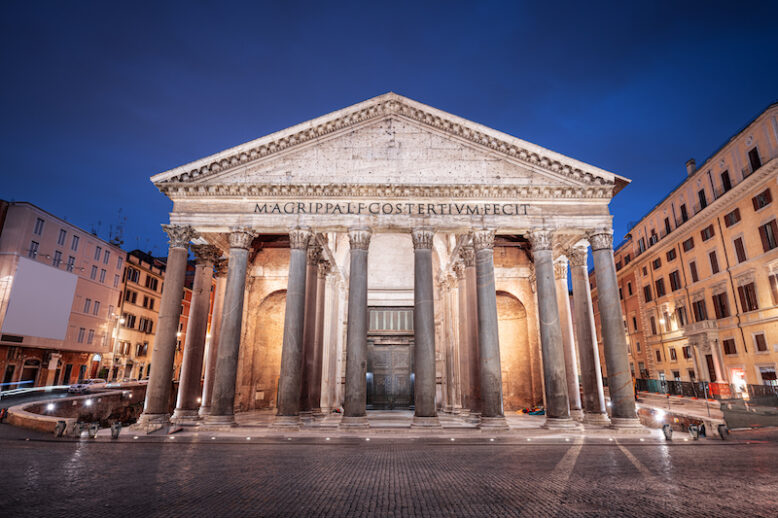
Campo de’ Fiori
It should be around lunchtime by now, and what better place to be than Campo de’ Fiori, a charming square home to Rome’s most famous outdoor market. Back in the day, this place was a flowery field that later turned into a hub with inns and shops, and a site for public executions, such as that of the philosopher Giordano Bruno in 1600.
Today, Campo de’ Fiori welcomes visitors with a kaleidoscope of colors, smells, and sounds, thanks to its bustling market open from Monday to Saturday until 2 pm (sure, it’s a bit touristy these days, but hey, when in Rome!). Come evening, the piazza is the perfect spot for aperitifs and becomes a true epicenter of Rome’s nightlife.
And let’s talk about food! There’s so much to choose from here. You can grab heavenly focaccia with mortadella from Forno Campo De’ Fiori or try the famous battered cod fillets at Dar Filettaro a Santa Barbara. Alternatively, enjoy a proper sit-down lunch at a place like Luciano for that carbonara you’ve been craving!
Campo de’ Fiori
Dovrebbe ormai essere l’ora di pranzo e non c’è posto migliore in cui trovarsi se non Campo de’ Fiori, una delle piazze più incantevoli di Roma, rinomata per il suo mercato all’aperto. Originariamente un campo fiorito, questo luogo ha attraversato diverse trasformazioni nel corso dei secoli, diventando un vivace centro con locande e botteghe e persino luogo di esecuzioni pubbliche, come quella del filosofo Giordano Bruno nel 1600.
Oggi, Campo de’ Fiori accoglie i visitatori con un’esplosione di colori, odori e suoni, grazie al suo animato mercato che si svolge dal lunedì al sabato fino alle 14 (è diventato un po’ turistico, ma quando si è a Roma, un giro qui è d’obbligo!). Verso sera, la piazza si trasforma nel luogo ideale per un aperitivo, diventando l’epicentro della nightlife romana.
E che dire del cibo? Le opzioni qui sono infinite! Puoi deliziarti con una focaccia con mortadella al Forno Campo De’ Fiori oppure assaggiare i famosi filetti di merluzzo fritti del Dar Filettaro a Santa Barbara. Oppure, concediti un pranzo come si deve in un posto come Luciano, magari ordinando quella carbonara che desideravi tanto!
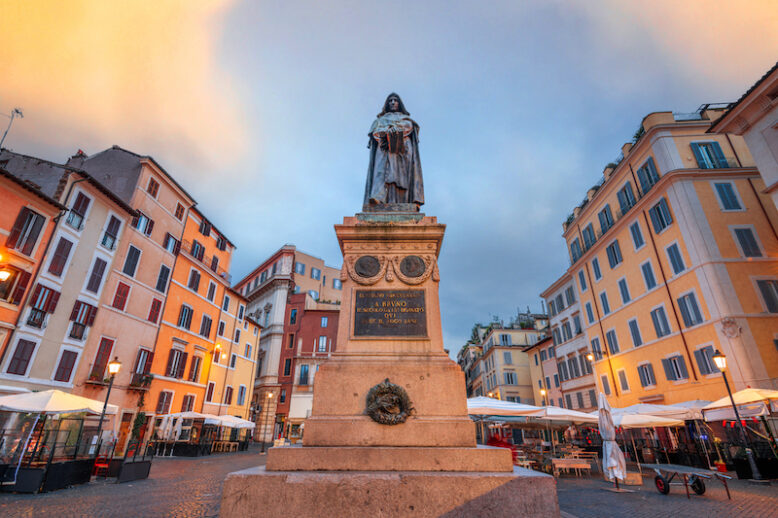
Piazza Navona
Enjoy a post-lunch stroll, just like the Italians do, and head to Piazza Navona, one of Italy’s prettiest squares. Originally a stadium back in ancient Rome, it still retains its elongated shape, offering a place to immerse yourself in the beauty and culture of Rome.
Three beautiful fountains grace the square: the magnificent Fountain of the Four Rivers sculpted by Gian Lorenzo Bernini in the 17th century, the evocative Moor Fountain, and the sumptuous Neptune Fountain. All around are elegant palaces and lively cafes, with street artists and vendors adding to the lively atmosphere.
Should there be space left for a sweet indulgence post-meal, head over to 100 Tiramisù. They’ve got a whopping 100 different kinds of tiramisù to choose from. Decisions, decisions!
Piazza Navona
Goditi una passeggiata post-pranzo, proprio come fanno gli italiani, e dirigiti verso Piazza Navona, una delle piazze più belle d’Italia. Originariamente uno stadio nell’antica Roma, conserva ancora la sua forma allungata, offrendo un luogo per immergersi nella bellezza e nella cultura romana.
Questa piazza incanta con tre splendide fontane: la magnifica Fontana dei Quattro Fiumi, opera di Gian Lorenzo Bernini del XVII secolo, la suggestiva Fontana del Moro e la sontuosa Fontana di Nettuno. Tutt’intorno ci sono eleganti palazzi e animati caffè, con artisti di strada e venditori che contribuiscono a creare una vivace atmosfera.
Se hai ancora un piccolo spazio dopo il pranzo, concediti una breve sosta al 100 Tiramisù. Qui potrai scegliere tra una selezione di ben 100 varietà di tiramisù. Ah, che bel dilemma!
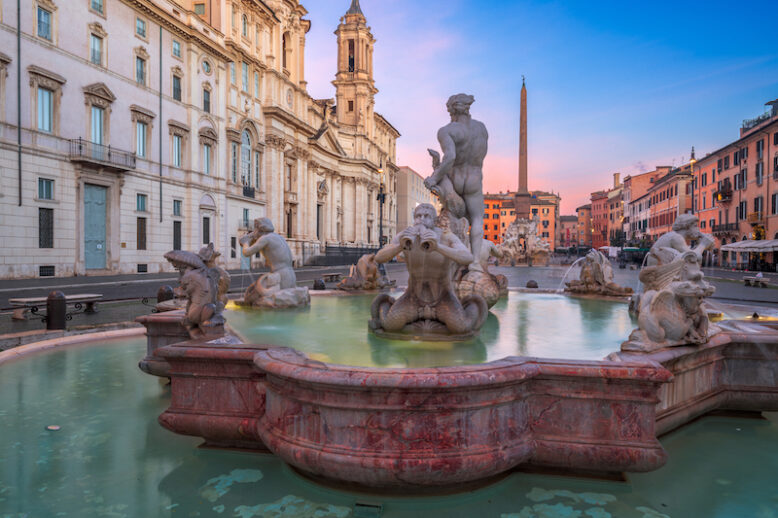
Piazza del Popolo
From Piazza Navona, a quick walk leads you to the banks of the Tiber, Rome’s iconic river. Consider a brief detour to Piazza di Ponte S. Angelo for picturesque views of the majestic Castel Sant’Angelo, or proceed directly to Piazza del Popolo, tracing the elegant curves of the river along the way.
Located at the foot of the charming Pincio terrace and the expansive Villa Borghese park (both accessible for free), this square served as the primary entrance to the city in ancient Roman times and marks the convergence of three iconic streets of the historic center: via del Babuino, via di Ripetta, and via del Corso.
Here, you’ll discover the Church of Santa Maria del Popolo, showcasing two paintings by Caravaggio, as well as the twin churches of S. Maria dei Miracoli and S. Maria in Montesanto (the latter known as the “Church of the Artists”). Further adorning this square is a massive red granite obelisk, the first to be transported to Rome during the reign of Augustus, to celebrate the conquest of Egypt.
Piazza del Popolo
Da Piazza Navona, una breve passeggiata conduce lungo le sponde del Tevere, il fiume iconico di Roma. Potresti optare per una breve deviazione verso Piazza di Ponte Sant’Angelo per ammirare il maestoso Castel Sant’Angelo in tutta la sua bellezza, oppure proseguire direttamente verso Piazza del Popolo, seguendo le eleganti curve del fiume.
Situata ai piedi della suggestiva terrazza del Pincio e del vasto parco di Villa Borghese (entrambi accessibili gratuitamente), questa piazza rappresentava ingresso principale alla città nell’antica Roma e segna il punto di convergenza di tre strade iconiche del centro storico: via del Babuino, via di Ripetta e via del Corso.
Qui, scoprirai la Chiesa di Santa Maria del Popolo, che custodisce due opere del Caravaggio, così come le chiese gemelle di S. Maria dei Miracoli e S. Maria in Montesanto (quest’ultima nota come la “Chiesa degli Artisti”). Ad abbellire ulteriormente questa piazza, si erge un imponente obelisco di granito rosso, il primo ad essere trasportato a Roma durante il regno di Augusto, per celebrare la conquista dell’Egitto.

Piazza di Spagna
Stroll down Via del Babuino (twinned with none less than Madison Avenue in New York!), then turn left onto Via Margutta, a street straight out of a storybook, adorned with art galleries, antique shops, and lively workshops where artists are busy creating. Check out Er Marmoraro for a piece of authentic Roman craftsmanship to take home.
Next up is Piazza di Spagna, the heart of Rome’s elegance and glamour. Here, the Spanish Steps rise majestically, once a rendezvous spot for artists and hopeless romantics (just remember, no sitting allowed!). Climb to the top for an incredible view from the Church of the Santissima Trinità dei Monti, with Bernini’s beautiful Barcaccia fountain down below.
In this area, you’ll find high-end boutiques and historic gems like the Keats-Shelley Memorial House (a must-visit for literature lovers). Be sure to indulge in a classic espresso at one of the historic establishments like Babington’s or the Antico Caffè Greco, which is the second oldest café in Italy, after Caffè Florian in Venice.
Piazza di Spagna
Cammina lungo Via del Babuino (gemellata con Madison Avenue a New York!), poi gira a sinistra in Via Margutta, un’incantevole strada che sembra uscita da un libro di fiabe, ricca di gallerie d’arte, negozi d’antiquariato e vivaci laboratori dove gli artisti danno vita alle loro creazioni. Visita Er Marmoraro per portare a casa un autentico capolavoro di artigianato romano.
Proseguendo, arriverai a Piazza di Spagna, il cuore glamour ed elegante di Roma. La sua iconica scalinata è stata per anni luogo di incontro per artisti e romantici sognatori (ricorda, però, che non è più consentito sedersi!). Salendo in cima, potrai godere di una vista mozzafiato dalla Chiesa della Santissima Trinità dei Monti, con la splendida fontana della Barcaccia di Bernini proprio ai piedi della scalinata.
In questa affascinante zona troverai boutique di alta moda e gioielli storici come la Casa Museo Keats-Shelley, una tappa imprescindibile per gli amanti della letteratura. Puoi inoltre concederti una pausa caffè da Babington’s o all’Antico Caffè Greco, il secondo caffè più antico d’Italia dopo il Caffè Florian a Venezia.

Fontana di Trevi
Stroll through the bustling streets of Rome’s city center for another ten minutes, and ta-da! You’ll find yourself standing before the iconic Fontana di Trevi, another absolute must-see for your day in Rome. Rumors have it that its construction drained the city’s coffers so much that they had to tax wine to cover the costs! And there’s good reason to believe it: towering at 26 meters, crafted from exquisite travertine and Carrara marble, it stands as a grand representation of Oceanus atop a shell-shaped chariot pulled by seahorses and tritons – a sight of pure beauty!
Tradition says you’ve got to toss a coin into the fountain for a guaranteed return to Rome. And here’s a little secret for you: just a stone’s throw away lies the Church of Santa Maria in Via, known as Rome’s Little Lourdes. Why? Well, it’s home to an ancient well where you can sip on miraculous water.
Fontana di Trevi
Passeggia per le affollate strade del centro di Roma per altri dieci minuti e ta-da! Ecco l’iconica Fontana di Trevi, altro assoluto must per la tua giornata a Roma. Si racconta che la sua costruzione abbia prosciugato le casse della città a tal punto da dover tassare persino il vino per coprire i costi! E non c’è da meravigliarsi: alta 26 metri, realizzata con pregiato travertino e marmo di Carrara, la fontana è un’epica rappresentazione di Oceano su un carro a forma di conchiglia, trainato da cavalli marini e tritoni – pura bellezza!
Secondo la tradizione, gettare una moneta nella fontana assicura il tuo ritorno nella città eterna. Ma ecco un piccolo segreto per te: a due passi da qui, si trova la Chiesa di Santa Maria in Via, conosciuta come la Piccola Lourdes di Roma. Perché? Beh, è sede di un antichissimo pozzo dove puoi bere acqua considerata miracolosa.
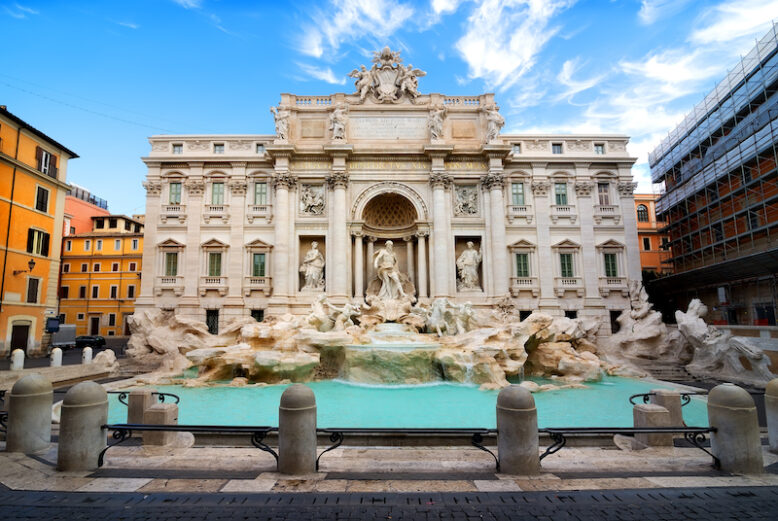
Returning to Termini station or venturing into Trastevere?
If your one day in Rome doesn’t extend into the night, it’s likely time to catch a train. From the Trevi Fountain, a quick walk to Barberini metro station followed by just two stops on Line A towards Anagnina will get you to Termini station.
Should you find yourself with a bit of time before your train departs, treat yourself to a well-deserved aperitivo, the perfect farewell to the eternal city. Several delightful options await in the area, such as Mercato Centrale, Amodei, or the rooftop bar of Hotel Independent.
However, if you plan to extend your stay into the evening, Trastevere is a must-visit. This super charming neighbourhood embodies quintessential Rome with its narrow, colorful streets, cozy restaurants, and little shops. Surely, the best place to enjoy a lovely night indulging in some amazing Roman food in places like da Enzo al 29 or Mozzichi.
Now, Trastevere, whose name means “beyond the Tiber,” lies on the opposite bank of the river from the old center of Rome. And here’s the thing, there’s no metro station in the area, so the best option to get here is to grab a taxi.
Tornare a Termini o avventurarsi a Trastevere?
Se non trascorrerai la notte a Roma, probabilmente è giunto il momento di prendere un treno. Dalla Fontana di Trevi, basta una breve passeggiata fino alla stazione della metropolitana Barberini, e con solo due fermate sulla Linea A in direzione Anagnina, giungerai alla stazione Termini.
Qualora avessi ancora un po’ di tempo prima della partenza del tuo treno, concediti un meritato aperitivo – non c’è modo migliore per salutare la Città Eterna. Troverai diverse opzioni in zona, tra cui il Mercato Centrale, Amodei o il bar panoramico dell’Hotel Independent.
Se invece hai deciso di restare in città anche per la notte, una visita a Trastevere è d’obbligo. Questo incantevole quartiere è un vero e proprio concentrato di romanità, con le sue pittoresche stradine, i ristoranti accoglienti e i piccoli negozi. È il luogo ideale per godersi una serata all’insegna della cucina romana in locali come da Enzo al 29oMozzichi.
Trastevere, il cui nome significa “oltre il Tevere”, si trova sulla sponda opposta del fiume rispetto al centro storico di Roma. Non esiste una stazione della metropolitana in zona, l’opzione più comoda per arrivare fin qui è prendere un taxi.

Valentina Nicastro is a travel writer in love with her home country, Italy. Having travelled widely around the globe, she realised there was more to explore closer to home and decided to put the passport aside for a while. When she is not immersed in documenting Italy, you’ll find her donning her communication consultant hat, weaving words as a content writer and bridging linguistic divides as a translator.


